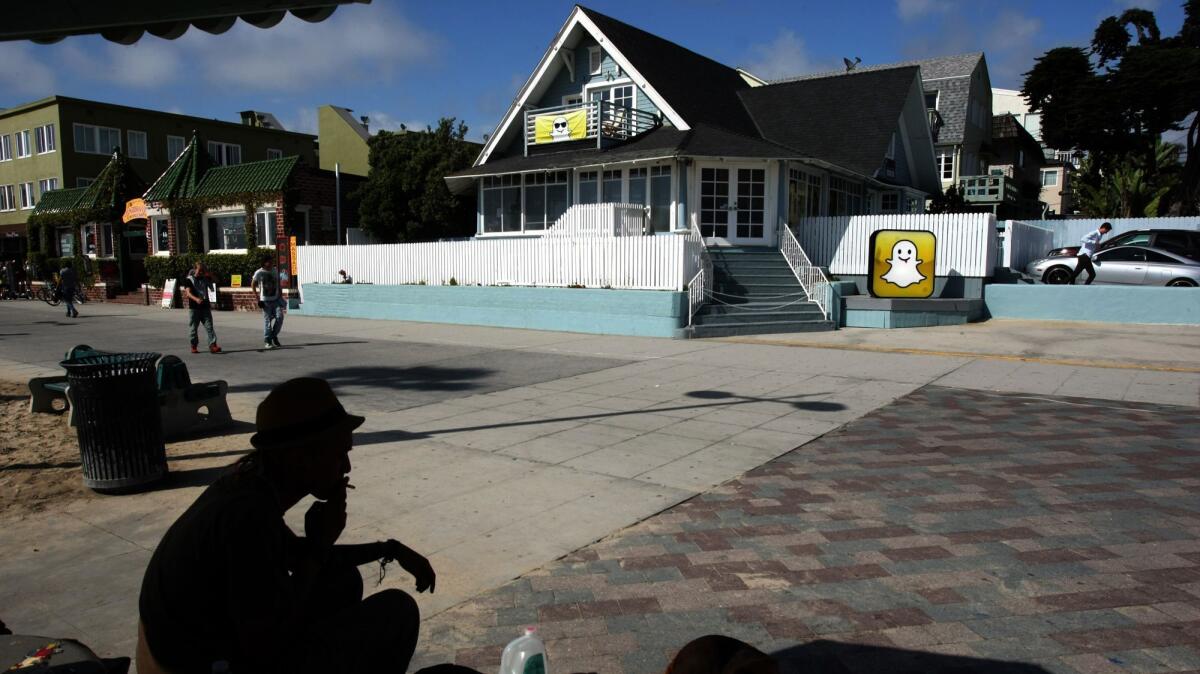Why Snapchat’s unprecedented real estate strategy in Venice could be tech’s new standard

A tech start-up based in Los Angeles rather than Silicon Valley. A mobile app that built its appeal by deleting photos and messages. Vertical video in a widescreen world.
Snapchat, the popular photo and video messaging app, has broken the mold in many ways. Now, with parent company Snap Inc.’s initial public stock offering only days away, it is poised to do so again.
Snap will begin trading on public markets without a designated headquarters, an anomaly in the tech world. None of Snap’s peers — the 10 California-based technology companies with the biggest IPOs of the last 15 years — lacked a corporate headquarters when it went public.
Snap knows its strategy is unusual: The company listed its lack of a headquarters and spread-out West L.A. offices on its financial filings as a risk that could potentially harm its business and future revenue prospects.
“This diffuse structure may prevent us from fostering positive employee morale and encouraging social interaction among our employees and different business units,” the filing stated. “Moreover … we may be unable to adequately oversee employees and business functions.”
In an era when companies such as Google, Facebook and Apple have created an expectation that tech firms will offer sprawling corporate campuses with gyms, chefs preparing organic food and massage services on site, Snap’s scattered layout could strengthen its brand as an outsider that challenges the status quo. Or it could prove to be a liability that hinders innovation and productivity, experts say.
Snap has been a rebel from the start. In 2013, founder and Chief Executive Evan Spiegel left Palo Alto and set up shop in Venice Beach, hoping to escape both Silicon Valley and corporate culture. The company quickly outgrew its beachfront bungalow but chose to expand within Venice and nearby Marina del Rey rather than consolidate in a single location.
This strategy has some benefits. Snap, whose emphasis on secrecy extends beyond its self-destructing messages, always strives to surprise its users. By isolating teams in separate facilities, it can limit those in the know about projects outside their own — potentially reducing the likelihood that details leak out. Workers take shuttles or walk between offices, which some say has deepened their desire to volunteer locally. They can eat at beachside cafes and support local businesses, thanks to Snap vouchers.
And then there’s the aura.
“Venice is younger and grittier” — more South of Market than Silicon Valley,” said Bryan Dunne, a commercial office broker in West L.A., referring to a neighborhood in San Francisco.
But at the same time,“It’s extremely supply constrained and there’s not that many large projects,” Dunne said.
For that reason, he said, tech giants such as Oracle Corp. and Amazon.com Inc. have generally chosen spaces where they have the ability to keep growing without relocating: the Water Garden complex in Santa Monica, for example, or new developments in Playa Vista.
Even Google — the pioneer in bucking workplace convention — “had no choice” but to expand in Playa Vista once it outgrew its Los Angeles home in Venice, Dunne said.
Consolidating office space into a single campus is beneficial for an obvious reason, said Sigal Barsade, a professor of management at the Wharton School of the University of Pennsylvania: It brings people together.
A company’s culture is often set from the top down, Barsade said. Employees absorb it by observing company leaders and one another.
“It’s easier to maintain consistency in the messages that you’re sending in terms of culture when literally people are in the same location and it gives more opportunity to see the culture enacted,” Barsade said.
When we say ‘kind,’ we mean the type of kindness that compels you to let someone know that they have something stuck in their teeth.
— Snap’s SEC filing
A strong culture, in turn, translates to improved morale and productivity. “People like to feel like they fit in and are part of something,” Barsade said. “You also know better what to do and how to do it.”
But companies can succeed without consolidating, she said. “It’s not a fatal flaw. It just means that they have to be very, very conscious of how they’re going to [achieve] the cohesion, the transfer of norms and values, the transfer of knowledge” that you get from being in one place, she said.
Barsade pointed to Southwest Airlines, which has built a strong culture and a productive business despite having employees all over the country.
Snap declined to comment for this story, but in its filings with the Securities and Exchange Commission the company made clear it has a strong sense of its own culture. “Our team is kind, smart and creative,” the filing stated. “When we say ‘kind,’ we mean the type of kindness that compels you to let someone know that they have something stuck in their teeth even though it’s a little awkward.”
The company has created a charity, the Snap Foundation, and a slush fund — “Snap-a-Wish” — to help employees in an emergency. And it established what it calls Council, a kind of biweekly group therapy, to enable employees to connect in person.
But consolidated offices aren’t just a vehicle for promoting culture, experts said. They also cluster amenities in one place, reducing costs.
“If you’re providing a food service, you don’t want to have to do that 15 times in 15 different locations,” said Robert Mankin, a partner at the architecture firm NBBJ, which has designed corporate offices for technology companies.
More than the logistics, Mankin said, amenities — yoga classes, gardens, video game lounges — create chances for employees to rest, socialize and make new discoveries.
“With technology companies innovation is at the forefront of their thinking,” said Mankin. “They need a campus and they need amenities that will promote new ideas.”
Located just steps from the Venice boardwalk, Snap has what might be considered the ultimate playground: a wide expanse of sand and ocean, and an international tourist hot spot where every culture is on display.
Employees rate the beach as Snap’s top perk, but it can be hard to leverage in the same way, experts said.
A gaming lounge, for example, isn’t just a creative outlet or a distraction, said Mankin. It’s an opportunity to interact with a new colleague on the spur of the moment.
Those types of casual, spontaneous interactions are key for new learning and problem solving, said Jennifer Magnolfi, a researcher who studies tech workplaces.
“Traditionally it was very important to maximize efficiencies,” said Magnolfi, but today’s business leaders, especially in the highly competitive tech industry, are focused on maximizing learning.
That’s why the Googles and Facebooks of the world have built college-like campuses and designed them specifically to foster frequent serendipitous encounters, Magnolfi said.
But size also matters, Magnolfi said. Snap has only about 2,000 employees; Google has some 60,000. Smaller companies may not feel the same pressure to consolidate functions such as safety, transportation and network communications in one place.
Snap might also be creating a paradigm for the future, Magnolfi said.
The company — a start-up whose founder is 26 years old and whose target demographic is millennials — is young in every sense of the word. Its employees probably live their lives on mobile devices, connect to friends and colleagues through digital networks and are accustomed to frequent chance encounters with new information via the Internet, Magnolfi said.
“They have different expectations of how they navigate physical space,” she said. “A new model is possible.”
Magnolfi said that model still is taking shape, but one possibility is “a campus that weaves together” several workspaces across a neighborhood or city — similar to urban college campuses such as New York University.
“It thus mixes corporate and public spaces, employees and local community, with a sensibility that echoes many of our experiences in digital space, where these aspects of our lives are more interconnected,” Magnolfi said.
It’s a mix that hasn’t proven entirely popular in Venice, where neighbors blame the firm’s spread across 305,000-square-feet of office space for driving up real estate costs and making the offbeat neighborhood feel a bit more buttoned up.
Investors watching the IPO are probably not too worried about Snap’s lack of a campus, analysts said. If anything, they might simply chalk it up to more innovation from a company already known for being different.
“The guy is a game changer as far as the tech industry,” Jeff Zell, a senior research analyst at IPO Boutique, said of Spiegel. “He does things in his own, individual way.”
And whether Snap’s real estate is a helter-skelter array of offices or the workplace of the future, Zell said, the bottom line for investors will center on two things.
“How are you going to attract new users? And how are you going to increase the revenue?” he said. “All the rest is noise.”
Twitter: @AgrawalNina
ALSO
The luxury housing that Measure S would stop doesn’t actually require many evictions
So why is an AIDS nonprofit suing to halt construction and pushing for Measure S?
Developers are finally taking interest in South L.A. Will Measure S kill those dreams?
More to Read
Inside the business of entertainment
The Wide Shot brings you news, analysis and insights on everything from streaming wars to production — and what it all means for the future.
You may occasionally receive promotional content from the Los Angeles Times.







